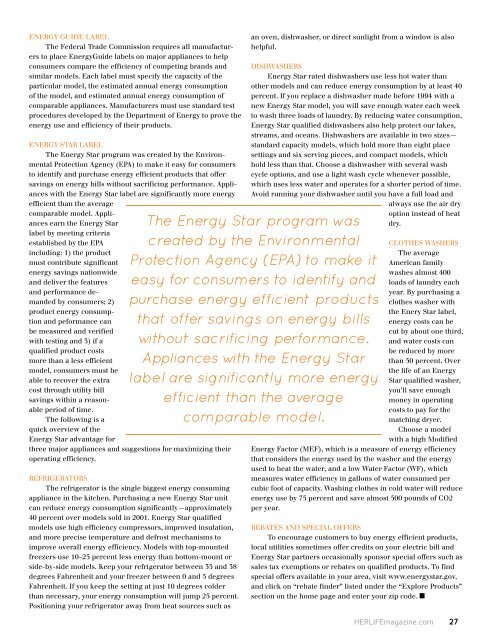Sarah Schachterle - HERLIFE Magazine
Sarah Schachterle - HERLIFE Magazine
Sarah Schachterle - HERLIFE Magazine
Create successful ePaper yourself
Turn your PDF publications into a flip-book with our unique Google optimized e-Paper software.
ENERGY GUIDE LABEL<br />
The Federal Trade Commission requires all manufacturers<br />
to place EnergyGuide labels on major appliances to help<br />
consumers compare the efficiency of competing brands and<br />
similar models. Each label must specify the capacity of the<br />
particular model, the estimated annual energy consumption<br />
of the model, and estimated annual energy consumption of<br />
comparable appliances. Manufacturers must use standard test<br />
procedures developed by the Department of Energy to prove the<br />
energy use and efficiency of their products.<br />
ENERGY STAR LABEL<br />
The Energy Star program was created by the Environmental<br />
Protection Agency (EPA) to make it easy for consumers<br />
to identify and purchase energy efficient products that offer<br />
savings on energy bills without sacrificing performance. Appliances<br />
with the Energy Star label are significantly more energy<br />
efficient than the average<br />
comparable model. Appliances<br />
earn the Energy Star<br />
label by meeting criteria<br />
established by the EPA<br />
including: 1) the product<br />
must contribute significant<br />
energy savings nationwide<br />
and deliver the features<br />
and performance demanded<br />
by consumers; 2)<br />
product energy consumption<br />
and peformance can<br />
be measured and verified<br />
with testing and 3) if a<br />
qualified product costs<br />
more than a less efficient<br />
model, consumers must be<br />
able to recover the extra<br />
cost through utility bill<br />
savings within a reasonable<br />
period of time.<br />
The following is a<br />
quick overview of the<br />
Energy Star advantage for<br />
three major appliances and suggestions for maximizing their<br />
operating efficiency.<br />
REFRIGERATORS<br />
The refrigerator is the single biggest energy consuming<br />
appliance in the kitchen. Purchasing a new Energy Star unit<br />
can reduce energy consumption significantly—approximately<br />
40 percent over models sold in 2001. Energy Star qualified<br />
models use high efficiency compressors, improved insulation,<br />
and more precise temperature and defrost mechanisms to<br />
improve overall energy efficiency. Models with top-mounted<br />
freezers use 10–25 percent less energy than bottom-mount or<br />
side-by-side models. Keep your refrigerator between 35 and 38<br />
degrees Fahrenheit and your freezer between 0 and 5 degrees<br />
Fahrenheit. If you keep the setting at just 10 degrees colder<br />
than necessary, your energy consumption will jump 25 percent.<br />
Positioning your refrigerator away from heat sources such as<br />
an oven, dishwasher, or direct sunlight from a window is also<br />
helpful.<br />
DISHWASHERS<br />
Energy Star rated dishwashers use less hot water than<br />
other models and can reduce energy consumption by at least 40<br />
percent. If you replace a dishwasher made before 1994 with a<br />
new Energy Star model, you will save enough water each week<br />
to wash three loads of laundry. By reducing water consumption,<br />
Energy Star qualified dishwashers also help protect our lakes,<br />
streams, and oceans. Dishwashers are available in two sizes—<br />
standard capacity models, which hold more than eight place<br />
settings and six serving pieces, and compact models, which<br />
hold less than that. Choose a dishwasher with several wash<br />
cycle options, and use a light wash cycle whenever possible,<br />
which uses less water and operates for a shorter period of time.<br />
Avoid running your dishwasher until you have a full load and<br />
always use the air dry<br />
option instead of heat<br />
The Energy Star program was<br />
created by the Environmental<br />
Protection Agency (EPA) to make it<br />
easy for consumers to identify and<br />
purchase energy efficient products<br />
that offer savings on energy bills<br />
without sacrificing performance.<br />
Appliances with the Energy Star<br />
label are significantly more energy<br />
efficient than the average<br />
comparable model.<br />
dry.<br />
CLOTHES WASHERS<br />
The average<br />
American family<br />
washes almost 400<br />
loads of laundry each<br />
year. By purchasing a<br />
clothes washer with<br />
the Enery Star label,<br />
energy costs can be<br />
cut by about one third,<br />
and water costs can<br />
be reduced by more<br />
than 50 percent. Over<br />
the life of an Energy<br />
Star qualified washer,<br />
you’ll save enough<br />
money in operating<br />
costs to pay for the<br />
matching dryer.<br />
Choose a model<br />
with a high Modified<br />
Energy Factor (MEF), which is a measure of energy efficiency<br />
that considers the energy used by the washer and the energy<br />
used to heat the water, and a low Water Factor (WF), which<br />
measures water efficiency in gallons of water consumed per<br />
cubic foot of capacity. Washing clothes in cold water will reduce<br />
energy use by 75 percent and save almost 500 pounds of CO2<br />
per year.<br />
REBATES AND SPECIAL OFFERS<br />
To encourage customers to buy energy efficient products,<br />
local utilities sometimes offer credits on your electric bill and<br />
Energy Star partners occasionally sponsor special offers such as<br />
sales tax exemptions or rebates on qualified products. To find<br />
special offers available in your area, visit www.energystar.gov,<br />
and click on “rebate finder” listed under the “Explore Products”<br />
section on the home page and enter your zip code.<br />
<strong>HERLIFE</strong>magazine.com 27

















